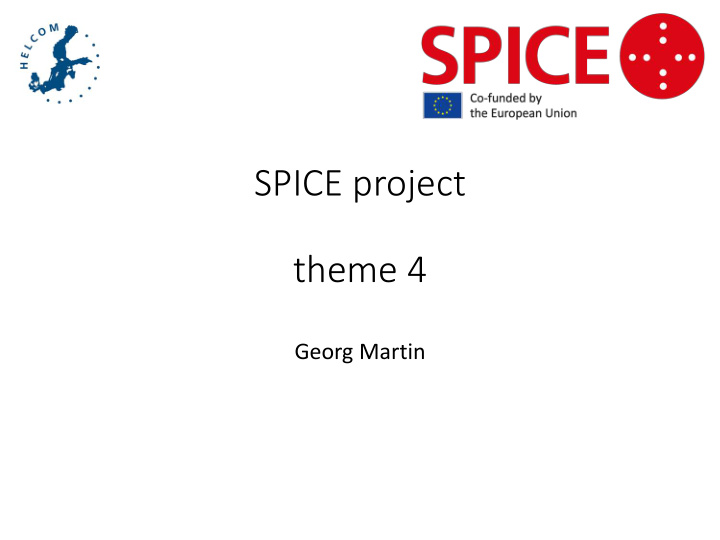



SPICE project theme 4 Georg Martin
Project description • Name: Implementation and development of key components for the assessment of Status, Pressures and Impacts, and Social and Economic evaluation in the Baltic Sea marine region (SPICE) • Coordinator: HELCOM • Duration (in months): 12 months • Partners: HELCOM, SYKE, SwAM, EMI, IMGW PIB, SEI Tallinn,
Aims of the project 1) finalize and quality assure the thematic assessments on biodiversity, eutrophication, hazardous substances as well as pressures and impacts and support the final collation of data and the visual presentation of results, 2) develop marine litter indicators towards operationalization and prepare a proposal for the assessment of marine litter in the 2nd holistic assessment, 3) further develop and implement the economic and social analyses at the Baltic Sea regional scale, 4) develop guidelines for assessments of cumulative impacts and thresholds related to pelagic and seabed habitats
General and specific objectives of the project General objectives: Finalization and refinement of the Second Holistic Assessment of the Ecosystem health of the Baltic Sea Specific objectives: Coordinated and coherent initial assessment for the Baltic Sea region, including determination of thresholds and baselines for selected indicators and further development of the economic and social analyses
Four themes Theme 1 : the assessments of biodiversity (descriptor 1), eutrophication (descriptor 5), hazardous substances (descriptor 8) and of the pressures, impacts, and human activities acting in the Baltic Sea region (Article 8b), based on approaches developed in the EU co-financed projects BalticBOOST and TAPAS, Theme 2: develop marine litter baselines and make a proposal for the assessment of marine litter in HOLAS II (descriptor 10), Theme 3 : implement regional social and economic analyses based on methodology developed in TAPAS, develop approaches for the regional baseline and integration of the assessment of activities, pressures, impacts and economic and social effects (Article 8c), Theme 4 : develop assessments of cumulative impacts and lost area related to pelagic and seabed habitats and thresholds for allowing assessment of GES in different habitat types (descriptors 1 and 6 and related criteria in other descriptors).
SPICE THEME 4: Cumulative impacts and maximum allowable pressures on habitats WP 4.1 An operational method for assessment of the extent of habitats lost and disturbed by human activities Tasks and approaches: 4.1.1 A step-wise method guideline for carrying out a technical assessment of the lost, disturbed and adversely affected area (km 2 ) of benthic and pelagic habitat types from different activities. 4.1.2 A practical guidance how different levels of EUNIS habitats (e.g. broader and more-detailed HELCOM underwater biotopes, both pelagic and benthic) can be tackled within the same assessment.
SPICE THEME 4: Cumulative impacts and maximum allowable pressures on habitats WP 4.2 Development of an approach to define thresholds for GES for the underwater habitat assessment Tasks and approaches: 4.2.1 Definition of adversely affected habitats. 4.2.2 Spatial data layers with realistic extent estimates of lost and disturbed habitats. 4.2.3 A cross-comparison of the area lost or disturbed against status assessments under different regimes (EU WFD, EU HBD, MSFD, HELCOM HOLAS I/II or core indicators). 4.2.4 Test thresholds for an assessment of habitats. 4.2.5 Propose how the thresholds can be applied for the development of environmental targets affecting seabed habitats.
SPICE THEME 4: Cumulative impacts and maximum allowable pressures on habitats WP4.3 Regional cooperation and dissemination of results on assessment of habitats Tasks and approaches: 4.3.1 Arranging a HELCOM workshop. 4.3.2 Participation in meeting and workshops arranged related to the assessment of habitats under the MSFD, e.g. the EcApHRA project.
SPICE THEME 4. Expected outcomes WP 4.1 An operational method for assessment of the extent of habitats lost and disturbed by human activities • Guidance document for data treatment and procedure to calculate the area and proportion of lost, disturbed and adversely affected benthic and pelagic habitats. • Practical guidance how different levels of EUNIS habitats (e.g. broader and more-detailed HELCOM underwater biotopes, both pelagic and benthic) can be tackled within the same assessment. WP 4.2 Development of an approach to define thresholds for GES for the underwater habitat assessment • Reports on the tested scenarios for the thresholds of adverse effects in pelagic and benthic habitats. • Reports on the tested scenarios for the proportion of lost and adversely affected areas in pelagic and benthic habitats. • Proposal how the tested scenarios would support the development of environmental targets. WP4.3 Regional cooperation and dissemination of results on assessment of habitats • Outcome of HELCOM workshop.
Recommend
More recommend